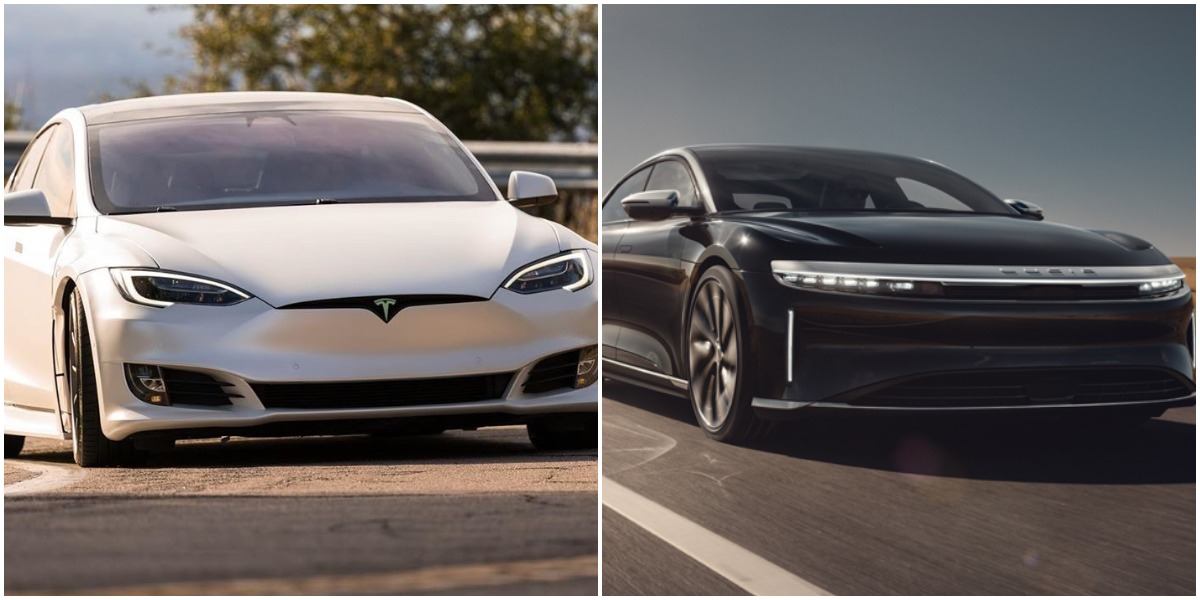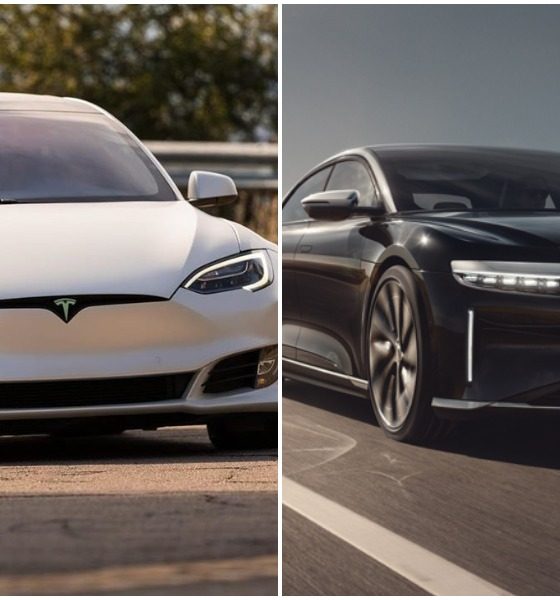

News
Tesla’s Standard Range strategy for Model S, X puts pressure on Lucid
Tesla’s Standard Range strategy with its flagship Model S and Model X is going to put pressure on the automakers that are emphasizing performance with their vehicles, especially Lucid Group, which has targeted Tesla’s two luxury vehicles with its lineup of Air sedan configurations.
Last night, Tesla officially added Standard Range versions of the S and X to its Design Studio, offering its luxury, high-performance vehicles to customers for a hefty discount. The performance metrics remained the same, the only difference was a reduction in range — 310 miles for the Model S, and 269 miles for the Model X.
Tesla Model S and Model X now more affordable with Standard Range variants
These two new configuration options from Tesla will have those on the ropes between Elon Musk’s company and Lucid, run by former Model S team member Peter Rawlinson, at a crossroads. However, the decision may be easier than ever before.
But the consequences Lucid might feel from Tesla’s new, cheaper configurations are more explicit than ever before. Tesla’s Long Range and Plaid configurations of the S and X were priced relatively similar to Lucid’s top-of-the-line offerings in the Air sedan.
The Model S Plaid comes in at $108,490 before options, and the Lucid Air Grand Touring, the most comparable to the Model S Plaid (within the same price range), is $125,600.
The Model S Plaid has a 1.99-second 0-60 MPH rate, while Lucid’s Air GT will get you there in 2.6 seconds. It trumps the Model S in range, offering 516 miles, while Tesla’s option is still nothing to bat an eye at, with 396 miles.
But now, pricing comes into focus, and undercutting the Air’s Pure configuration that starts at $82,400 by pricing a new Model S at $78,490 may make things a little easier for consumers and a little more difficult for Lucid.
Lucid missed consensus estimates on vehicle deliveries in Q2, as 1,404 cars made their way to customers. FactSet expected 2,000 cars, and struggling with demand, the last thing it needed was an automaker like Tesla to undercut its products with something superior for less money.
In terms of range, the Air is the best that you can get. But it is about more than that, including the vehicle’s ability to function as a daily driver. Lucid customers have reported issues with software in their vehicles, and as it has been a pain point for many automakers in the early development of EVs, it is something people just don’t want to deal with.
Tesla has its own issues, of course. People have recently come forth with claims that their cars get significantly lower range than they are rated for, and, depending on the person, Elon Musk is a touchy subject.
However, some people don’t give a damn about what the CEO does, they just want a car that works well and is priced reasonably. Lucid may have taken a drastic step back with Tesla’s new Model S and Model X trims. Pressure is being applied to rivals of Tesla through the company’s various price cuts in nearly every market.
In the U.S., Tesla put everyone in the hot seat early this year with massive price cuts, and it was up to the manufacturers to play ball or take their chances. Ford followed with price cuts of its own, and Lucid did, too.
Lucid introduces new $7,500 discount as EV price war heats up
However, their strategy did not translate to an overwhelming number of sales, and Lucid cut its delivery expectations to just 10,000 units in Q1, despite having over 28,000 reservations for its cars.
Tesla’s new rollout could be a true gut punch to Lucid as its Model S and Model X Standard Range offerings will give consumers one more reason to pick the unequivocal leader in EVs.
I’d love to hear from you! If you have any comments, concerns, or questions, please email me at joey@teslarati.com. You can also reach me on Twitter @KlenderJoey, or if you have news tips, you can email us at tips@teslarati.com.

News
Tesla FSD fleet is nearing 7 billion total miles, including 2.5 billion city miles
As can be seen on Tesla’s official FSD webpage, vehicles equipped with the system have now navigated over 6.99 billion miles.

Tesla’s Full Self-Driving (Supervised) fleet is closing in on almost 7 billion total miles driven, as per data posted by the company on its official FSD webpage.
These figures hint at the massive scale of data fueling Tesla’s rapid FSD improvements, which have been quite notable as of late.
FSD mileage milestones
As can be seen on Tesla’s official FSD webpage, vehicles equipped with the system have now navigated over 6.99 billion miles. Tesla owner and avid FSD tester Whole Mars Catalog also shared a screenshot indicating that from the nearly 7 billion miles traveled by the FSD fleet, more than 2.5 billion miles were driven inside cities.
City miles are particularly valuable for complex urban scenarios like unprotected turns, pedestrian interactions, and traffic lights. This is also the difference-maker for FSD, as only complex solutions, such as Waymo’s self-driving taxis, operate similarly on inner-city streets. And even then, incidents such as the San Francisco blackouts have proven challenging for sensor-rich vehicles like Waymos.
Tesla’s data edge
Tesla has a number of advantages in the autonomous vehicle sector, one of which is the size of its fleet and the number of vehicles training FSD on real-world roads. Tesla’s nearly 7 billion FSD miles then allow the company to roll out updates that make its vehicles behave like they are being driven by experienced drivers, even if they are operating on their own.
So notable are Tesla’s improvements to FSD that NVIDIA Director of Robotics Jim Fan, after experiencing FSD v14, noted that the system is the first AI that passes what he described as a “Physical Turing Test.”
“Despite knowing exactly how robot learning works, I still find it magical watching the steering wheel turn by itself. First it feels surreal, next it becomes routine. Then, like the smartphone, taking it away actively hurts. This is how humanity gets rewired and glued to god-like technologies,” Fan wrote in a post on X.
News
Tesla starts showing how FSD will change lives in Europe
Local officials tested the system on narrow country roads and were impressed by FSD’s smooth, human-like driving, with some calling the service a game-changer for everyday life in areas that are far from urban centers.

Tesla has launched Europe’s first public shuttle service using Full Self-Driving (Supervised) in the rural Eifelkreis Bitburg-Prüm region of Germany, demonstrating how the technology can restore independence and mobility for people who struggle with limited transport options.
Local officials tested the system on narrow country roads and were impressed by FSD’s smooth, human-like driving, with some calling the service a game-changer for everyday life in areas that are far from urban centers.
Officials see real impact on rural residents
Arzfeld Mayor Johannes Kuhl and District Administrator Andreas Kruppert personally tested the Tesla shuttle service. This allowed them to see just how well FSD navigated winding lanes and rural roads confidently. Kruppert said, “Autonomous driving sounds like science fiction to many, but we simply see here that it works totally well in rural regions too.” Kuhl, for his part, also noted that FSD “feels like a very experienced driver.”
The pilot complements the area’s “Citizen Bus” program, which provides on-demand rides for elderly residents who can no longer drive themselves. Tesla Europe shared a video of a demonstration of the service, highlighting how FSD gives people their freedom back, even in places where public transport is not as prevalent.
What the Ministry for Economic Affairs and Transport says
Rhineland-Palatinate’s Minister Daniela Schmitt supported the project, praising the collaboration that made this “first of its kind in Europe” possible. As per the ministry, the rural rollout for the service shows FSD’s potential beyond major cities, and it delivers tangible benefits like grocery runs, doctor visits, and social connections for isolated residents.
“Reliable and flexible mobility is especially vital in rural areas. With the launch of a shuttle service using self-driving vehicles (FSD supervised) by Tesla in the Eifelkreis Bitburg-Prüm, an innovative pilot project is now getting underway that complements local community bus services. It is the first project of its kind in Europe.
“The result is a real gain for rural mobility: greater accessibility, more flexibility and tangible benefits for everyday life. A strong signal for innovation, cooperation and future-oriented mobility beyond urban centers,” the ministry wrote in a LinkedIn post.
News
Tesla China quietly posts Robotaxi-related job listing
Tesla China is currently seeking a Low Voltage Electrical Engineer to work on circuit board design for the company’s autonomous vehicles.

Tesla has posted a new job listing in Shanghai explicitly tied to its Robotaxi program, fueling speculation that the company is preparing to launch its dedicated autonomous ride-hailing service in China.
As noted in the listing, Tesla China is currently seeking a Low Voltage Electrical Engineer to work on circuit board design for the company’s autonomous vehicles.
Robotaxi-specific role
The listing, which was shared on social media platform X by industry watcher @tslaming, suggested that Tesla China is looking to fill the role urgently. The job listing itself specifically mentions that the person hired for the role will be working on the Low Voltage Hardware team, which would design the circuit boards that would serve as the nervous system of the Robotaxi.
Key tasks for the role, as indicated in the job listing, include collaboration with PCB layout, firmware, mechanical, program management, and validation teams, among other responsibilities. The role is based in Shanghai.
China Robotaxi launch
China represents a massive potential market for robotaxis, with its dense urban centers and supportive policies in select cities. Tesla has limited permission to roll out FSD in the country, though despite this, its vehicles have been hailed as among the best in the market when it comes to autonomous features. So far, at least, it appears that China supports Tesla’s FSD and Robotaxi rollout.
This was hinted at in November, when Tesla brought the Cybercab to the 8th China International Import Expo (CIIE) in Shanghai, marking the first time that the autonomous two-seater was brought to the Asia-Pacific region. The vehicle, despite not having a release date in China, received a significant amount of interest among the event’s attendees.








